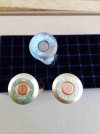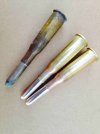You'll get lots of different responses, and its not to say that any one is correct or not. Its what works for you with your rifle, powder, bullets, lube, etc. I doubt that you'll ever have anyone advocate air space in the cartridges, so that means 100% or more load density. Real blackpowder is easily ignited, so a mild primer is plenty, and was usually my preference. I did a primer test once upon a time and found that just changing the primer in a particular 45-70 load had groups vary from ~MOA to almost 4 MOA at 385 meters. WW LRM were the worst, RP 2-1/2 large pistol primers were the best, with F210s, WLR and F215s between. In a couple of 38-55s, there was a distinct preference to WLR over the others.
I recall that the competitive shooters all used a 24" or longer drop tube to settle the powder in the cases whether it was just dumped or trickled, but the object was uniformity. Powder charges were measure thrown and not weighed, but again, uniformity was the goal, so a baffle in the measure helped, and keeping powder in a funnel in the top of the measure enhanced that. Powder was then compressed, with or without an over-powder wad using a compression die and not a bullet. I deal powder compression varied from brand/granulation/bullet weight, etc.
Most shooters used grooved, lubed bullets of groove diameter or larger. There were some who chose to use paper patched at bore size! Neck tension is another variable. I knew guys who shot "slip fit", meaning the bullet was literally a drop fit into the case. I suppose that is OK provided that you carefully handle your ammunition so the bullets don't fall out, and that the bullet is snug against the throat/rifling when chambered. I preferred just enough neck tension to make cartridges, so backed the FL sizer die out to partial size. An expander plug put just enough flare on the case to allow the bullet to seat easily, and I seated bullets between thumb and forefinger <snap> fit. I reasoned that using a die to seat might damage a soft bullet. I didn't remove the flare from the case, so the mouth of the case was snug in the chamber and kept the round centered. These were "match cartridges" and not hunting rounds. For rougher use, use more neck tension and remove most of the flare.
Most guys shot soft bullets, 20-1 to 40-1, but some shot whatever they had. Whatever your mix is, be consistent. Even hard alloy will obturate with BP as witnessed by 457125s found on a bank inthe spring. The full length of the nose was fully engraved, but the bullet was too hard to scratch with a thumbnail. Obviously it was too hard, engraved too much to be loaded without mechanical assistance, so "bumped up" upon ignition.
Bullet seating depth directly affects powder volume. The bullet needs to be seated deeply enough so as to chamber without an external device to cam the cartridge in. What works for a singleshot rifle may be too tight to chamber in a revolver or levergun.
Overpowder wads varied from poly sheet to card stock. Vegetable fiber based gasket material was used by some competitors....whatever works for you. Original cartridges varied from none to grease cookies sandwiched between card wads.
Powder choice is a whole 'nuther can o' worms. fffg is generally used in cartridges shared rifle/handgun, and ffg in most larger calibers. My 38-55s worked well with fffg, 45-70s with ffg, and 43 Mauser with fg. An original 43 Mauser cartridge from the 1880s contained a PP bullet, grease cookie between 2 card wads, and what appeared to be fg.
Choice of bullet lube for grooved bullets is another argument waiting to happen. SPG will melt if you leave your ammo in the sun. It will "bleed oil" if you put it in a lubrisizer. Generally, a beeswax base combined with vegetable oils or animal fats work well. You can wipe the bore between shots with a singleshot, but that is a no-go with a levergun or revolver.


